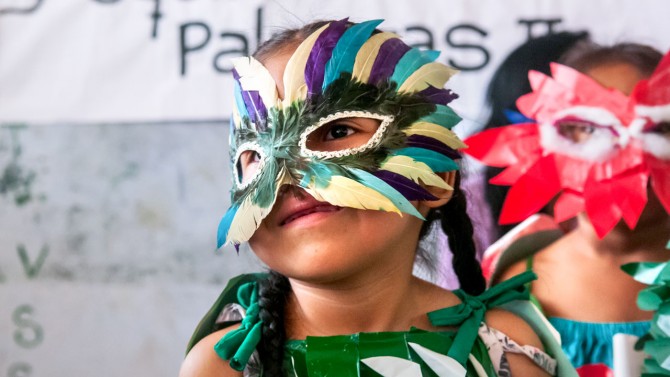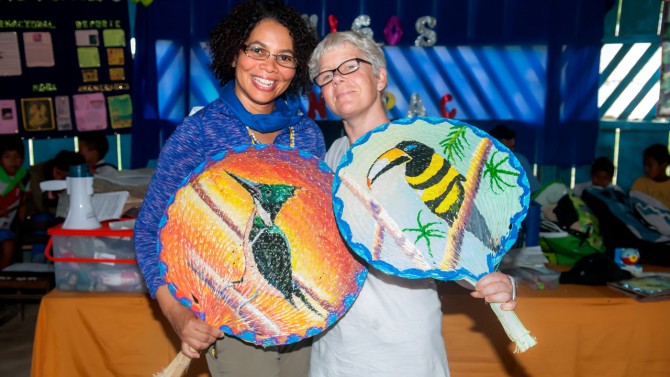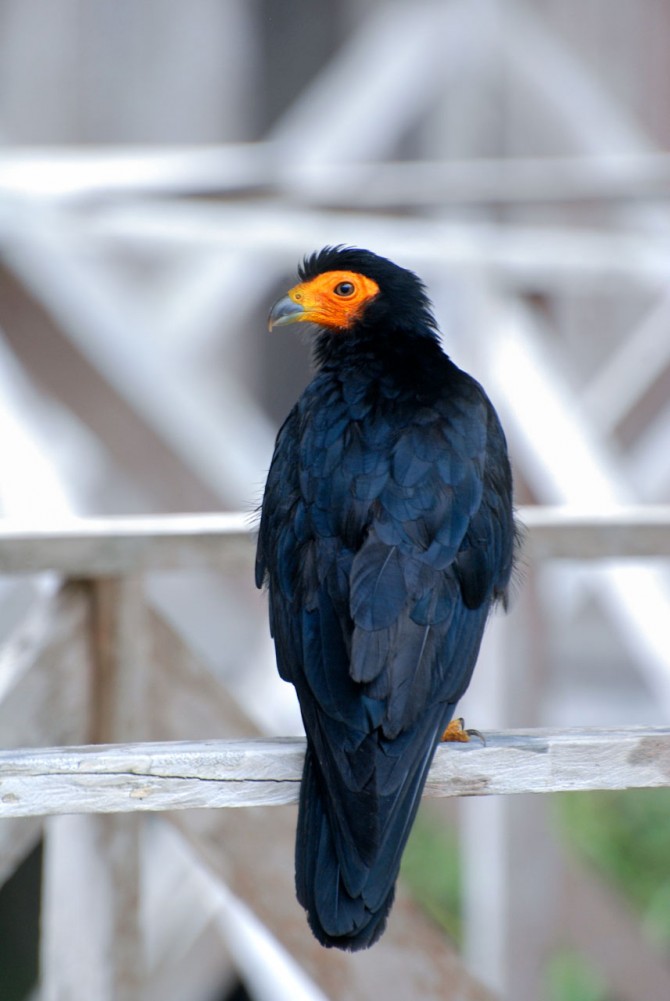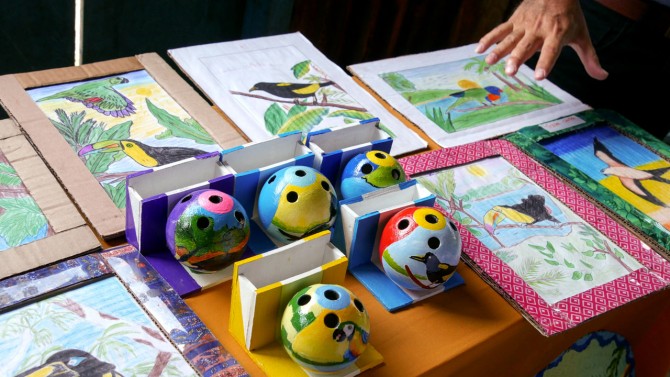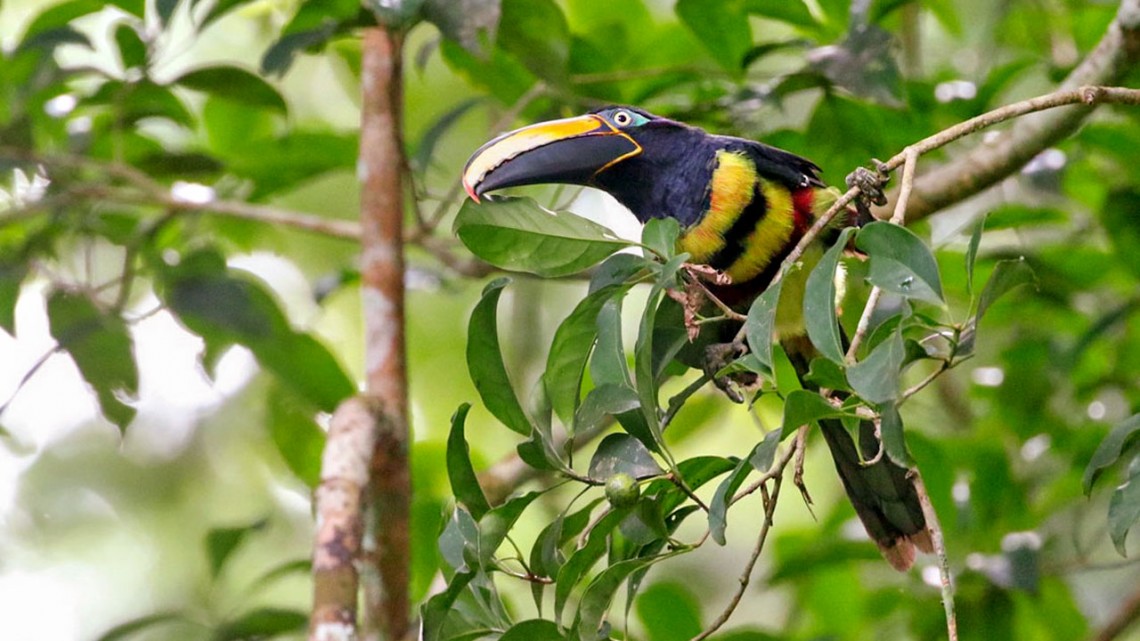
The many-banded aracari has 4-inch beak, eats mostly fruit and lives in the tropical lowlands of Peru, Brazil, Colombia, Ecuador and Venezuela.
In Peruvian Amazon, a celebration of birds takes flight
By Susan Kelley
Students, teachers, mothers and fathers arrived in dugout canoes after paddling for hours down the Amazon River. They brought bird costumes and bird-shaped signs they’d made out of recycled materials, and bird-themed plays and songs they’d written themselves.
Over five days in fall 2019, more than 900 Peruvians from 30 communities gathered in five villages in the Loreto region of Peru for festivals celebrating birds of the Peruvian Amazon. It was the latest chapter in an ongoing project – spanning three years of activity in 55 rural Amazonian communities and reaching 2,000 K-12 students – to co-create with community leaders, teachers and students a science project focused on birds and their role in the culture and ecosystem.
“Seeing their enthusiasm brought us to tears,” says Marilú López Fretts, a project assistant at the Cornell Lab of Ornithology. “We worked together side by side, taking into consideration the culture and respecting their knowledge.”
The project – Celebra las Aves en la Amazonía Peruana, or Celebrate Birds in the Peruvian Amazon – is a partnership between the Lab and the Civil Association for the Conservation of the Peruvian Amazon Environment (CONAPAC), a nonprofit in Iquitos, Peru.
In 2017, CONAPAC connected with Karen Purcell, project director for the Cornell Lab’s Celebrate Urban Birds citizen-science team, which works in the Americas to include people who are underrepresented in the sciences and elevate their role as stewards of the environment. Through the partnership, Peruvian teachers in Indigenous and mestizo communities co-created with the Cornell team a six-month interdisciplinary ornithology project.
Peru is home to more than 1,800 bird species and has been listed among the world’s best countries for bird-watching.
Initially the lesson plans focused on bird habitat, behavior, nesting and diet, as well as avian stewardship, science and the arts. López Fretts and Purcell began meeting with teachers once a month via Zoom and visiting the region twice a year. “This was an important part of gaining trust with the teachers and communities,” López Fretts says. They also created one of the few local bird guides in Spanish and local languages, geared toward students and featuring 22 birds.
“As they learn and add to what they know, they come to share the importance of birds and their own role as environmental stewards,” López Fretts says.
Since then, the project has resulted in a flowering of community interest in bird conservation far beyond anything Purcell and López Fretts could have scripted or even imagined, they say. Thanks to the collaboration of the Peruvian teachers, parents and students, entire communities are taking pride in the region’s birds. “It was them, not us, who created this,” López Fretts says. “They turned it into something beautiful.”
In 2018, the teachers wanted to instill in the students a sense of pride in the region’s birds and an interest in science by integrating the arts and culture into the curriculum.
Students interviewed elders to learn traditional songs and stories about birds and integrated them into books they made themselves, as well as into math and literature classes. Those traditional stories included beliefs about birds – hummingbird eggs bring good luck, for example, and the presence of an owl indicates someone nearby is pregnant.
With those stories, the teachers created meaningful community conversations about how beliefs, culture and conservation intersect. “These conversations include the entire community and lead to changes that are initiated by and desired in the community,” Purcell says; those changes include refraining from killing owls, no more stealing hummingbird eggs out of nests to bring good luck at bingo games, and avoiding shooting birds with slingshots indiscriminately.
“An institution like the Lab cannot just arrive in these communities and judge, teach and create change,” Purcell says. “It has to happen through co-creation and leadership from the communities. It’s not just about protecting the ecosystem, but about tapping into local pride and knowledge – and future sustainability.”
“The impact of this is showing immediately as more concern for birds,” says Brian Landever, director of CONAPAC. “Children are heard stopping their classmates from killing birds, and their parents are reporting no longer hunting birds in unsustainable ways.”
Concerned with economic development, communities have created 36 bird-watching trails to promote bird tourism, where local youth serve as guides; more are being planned. And most communities have created colorful murals encouraging bird conservation.
This spring, Purcell had planned to take 15 young people, along with teachers and parent chaperones, to a science conference where they would present their bird-related projects this spring. But the COVID-19 pandemic has put those plans on hold.
In the meantime, she and López Fretts are analyzing survey results from students, parents and community members, who say they are most interested in long-term economic sustainability, careers for youth, bird tourism and a desire to include the program in Peru’s national academic curriculum.
“It’s not just a project for schools where the kids are doing little projects,” Purcell says. “It’s the entire community coming together.”
“How do you encourage rural people to try to save the rainforest?” Landever asks. “The answer, thus far successful, is by working in an equitable and inclusive manner, side by side with local communities, and emphasizing the need to reflect on, respect and integrate Indigenous culture from the region.”
For more information, read “In Peru, A Celebratory Revolution Inspired By Birds,” an essay by Brian Landever, director of CONAPAC, that appeared in Living Bird magazine.
Media Contact
Get Cornell news delivered right to your inbox.
Subscribe